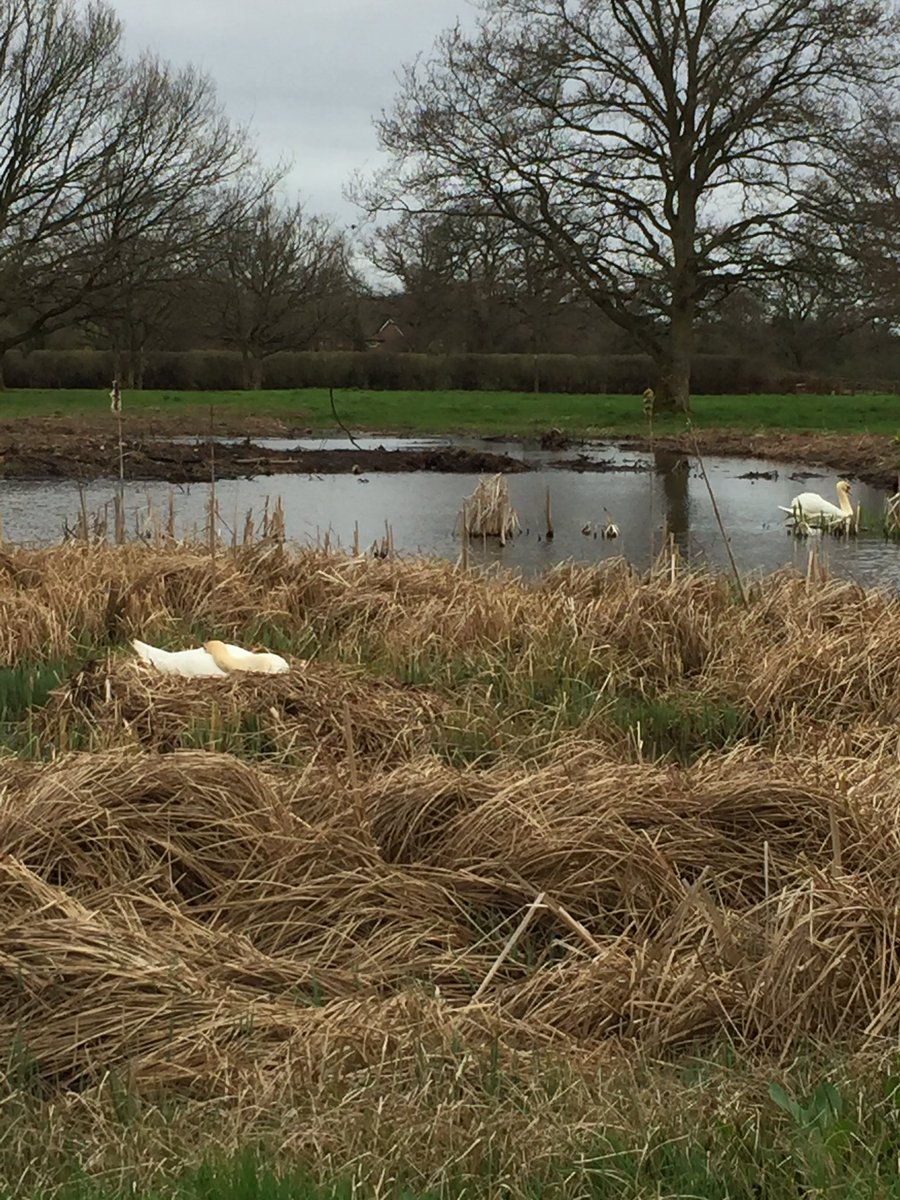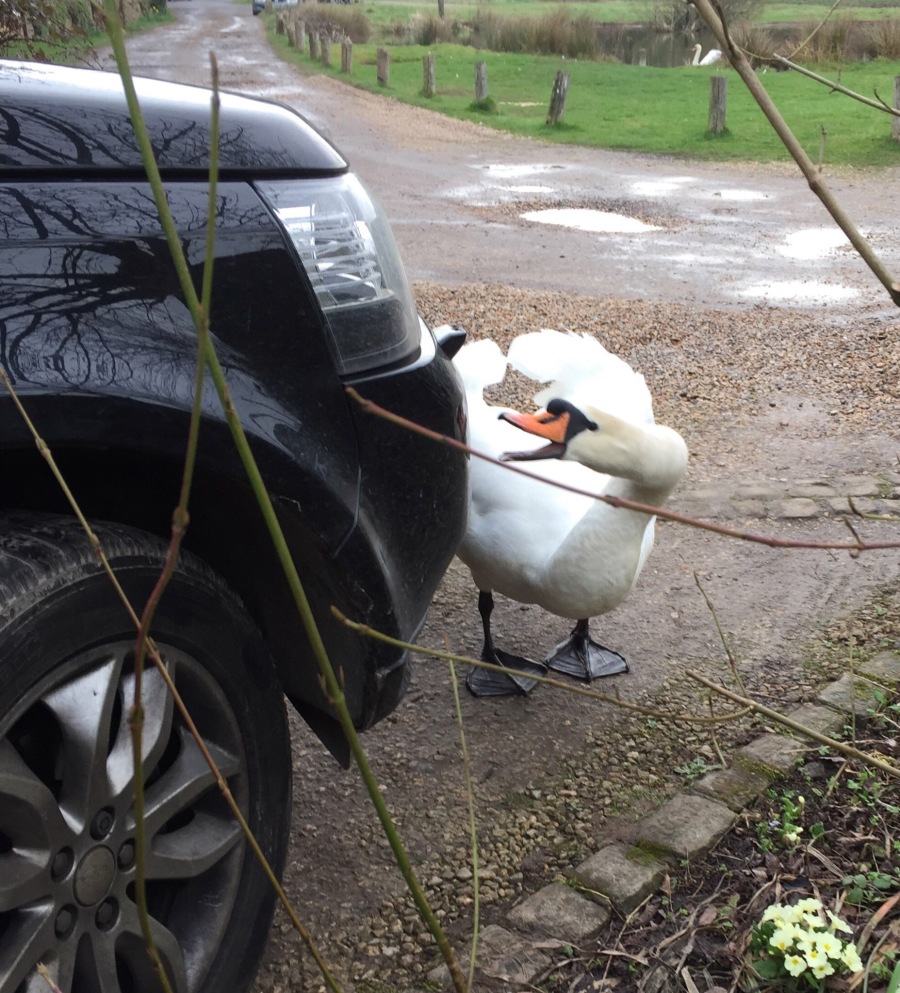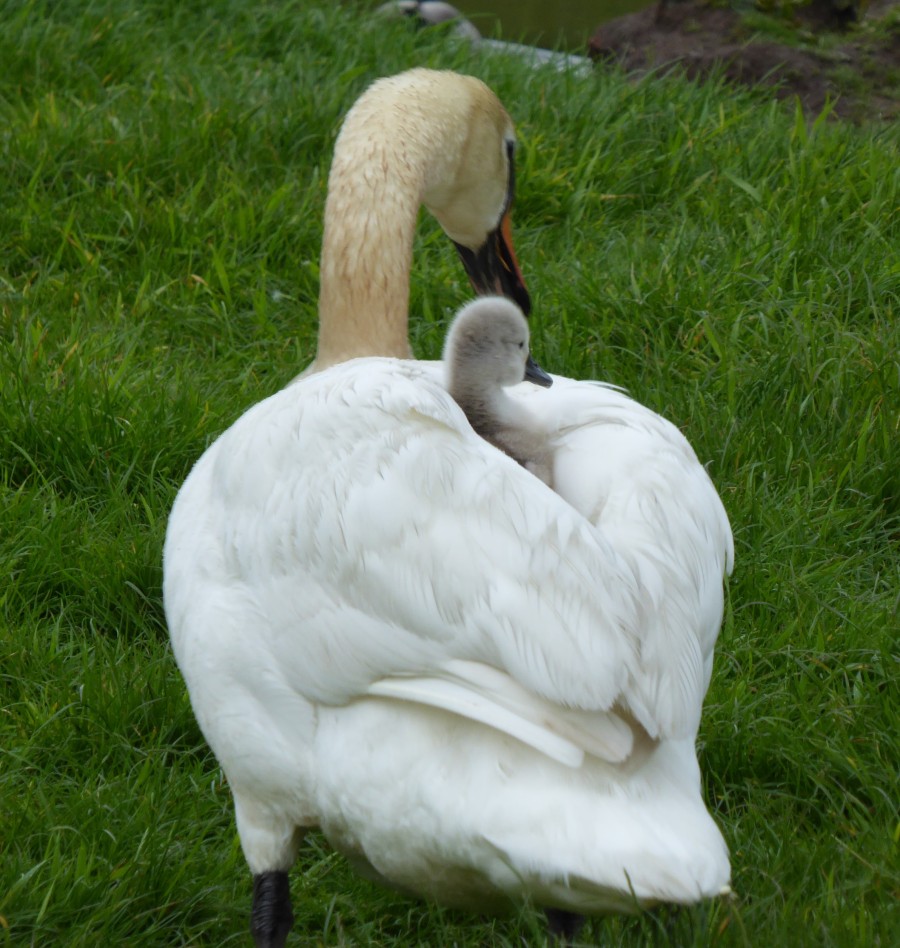It’s that time of year again, our female swan is now resident on the nest, whilst her spouse vehemently guards her – (well, until meal time arrives, then as usual he appears at the backdoor – all this defending business makes for hungry work, don’t you know)…?

During the breeding season Floppy turns into the Devil Swan….ten times more grumpy than usual. To make a quick trip across the track to a neighbour’s house takes careful planning and negotiation; timing is of the essence – it’s best to wait until he’s not around at all, if possible…. Wheels are a particular bug-bear of his, he can’t resist having a go at any passing vehicle; I have seen him launch himself at full pelt in order to get at the milkman’s truck…. As for the poor lady who delivers the newspapers, with her pull along trolley….he just cant help himself….

It’s common knowledge that breeding swans become more aggressive than usual; they are just doing their job, protecting their territory, nest and then once they arrive, their cygnets. There is no denying that a swan in full defensive mode is very imposing – one of Britain’s heaviest birds, at up to 15kg (33lbs) and with a wing span that can reach up to 2.4m (7.9ft), no wonder some people find them terrifying when confronted. Swans don’t attack just for the fun of it though (unless their name is Floppy)…. Generally, if you back away they will retreat, they may attempt to take a bite if you really overstep the mark…. A wing swipe can hurt but unless it’s to a young child or someone frail or elderly, the breaking of arms and legs is a misconception…. It was a myth put about by swan owners in the Middle Ages to stop poaching, when swans were considered a delicacy for the Royal dinner table….a myth that remained long after swan was taken off the menu. Out of the thousands of swans resident in Britain, to hear of a human being ferociously attacked by a swan is the rarest of occurrences….

The Crown claimed ownership on Britain’s mute swan population in the 12th Century, which is how the Queen now owns the majority of these majestic white birds….
It has been suggested that the mute swan, Cygnus Olor, was first introduced to Britain by the Romans, although remains have been found in East Anglia dating back to some 6,000 years ago. Naturally found in Africa, Asia, China, Europe and the Mediterranean area as well as the UK, the mute swan is adaptable to its surroundings. It can be found in coastal regions, on rivers and at estuaries, on ponds and lakes, grazing on flooded grasslands, in marshland and wetlands…. It has also been introduced to New Zealand, Australia, South Africa and North America…. Its diet consists mainly of aquatic plants, snails and it will graze on grass. If semi-tame, it will happily feed on grain and lettuce. Although swans enjoy bread it is not advisable to throw it into the water for them as it does pollute and poison the water….
Thanks to conservation efforts here in the UK the swan is now at ‘least concern’ level on the conservation status. During the 1980s the population was in rapid decline, especially on the River Thames. Numbers had begun to fall in the 60s, the main culprit – lead fishing weights. Since the ban of lead weights in the 80s and with the help of a series of mild winters, the mute swan population has recovered and is now back to the levels seen in the 1950s. Swans have few natural predators; foxes will take cygnets (as our pair found out the hard way last year). The biggest dangers to swans are pollution, discarded fishing tackle, overhead power cables, harsh winters (ponds freezing over, lack of food) and mankind….unfortunately, often through acts of vandalism….
Mute swans are protected under the Wildlife and Countryside Act of 1981 – the Act also covers eggs and nests. It is an offence to take or possess an egg and nests are protected whilst being built or used….
Occasionally swans get bad press. Most dog walkers are responsible, they keep their pets on leads when around swans, as they would around any wildlife or livestock…. However, you do hear of the occasional incident. Quite frankly, if a dog owner doesn’t have enough common- sense….well, I’d best not go there….
Sometimes a swan behaving badly makes the news; such as the apt named ‘Psycho Swan’ that terrorised members of a model boat club that regularly use a Suffolk lake…. In July 2016 the swan was responsible for the destruction of several model boats, much to the fury of the boats owners…. The ‘errant’ swan was the proud dad of four cygnets and was obviously taking his duties very seriously….no more needs to be said….

As the swan population increases the relationship between swans, farmers and those with fish interests can sometimes become stretched…. Natural food is at its scarcest between late Winter and early Spring – complaints from farmers about foraging swans have increased. Damage to crops, especially winter cereals and oilseed rape are rising, not just from being eaten but also from being trampled on and the ground being compacted. Some farmers plant decoy crops to try to tempt the plundering swans away from the main crop….others resort to bird scarers….
Another area where swans are falling out of favour is with the river management authorities. Studies have been conducted by DEFRA on rivers; for example the Rivers Itchen and Test (Hampshire) and the Kennet and Lower Avon (Wiltshire and Berkshire) and the adjacent agricultural land. Results showed that groups of swans only used part of the river, so damage remained localised. The plant community was the main sufferer, typically water crowfoot, a favourite food source for grazing swans; this effects conservation and angling value. Moving groups of swans away from more sensitive areas may help to manage the impact of their grazing; fencing off areas does not appear to work, suspended tape to deter the birds might help – but this is a pricey option. There is no conclusive answer – however, non-lethal methods do have to be found. At least as a result of the studies, authorities are beginning to understand the impacts on the chalk river eco-system and hopefully a practical, effective solution will be found….
British swans can perhaps thank their lucky stars that as current legislation stands, they are fully protected under the Wildlife and Countryside Act…. Which is more than can be said for their American cousins….
The mute swan first arrived in the States in the late 1800s – brought over from Europe to decorate the ornamental ponds and lakes of wealthy landowners. Quickly numbers increased and feral colonies formed….
The majority of American people see the mute swan as a creature of beauty….but there are those who view it as an invasive species that destroys the natural habitats of ducks, geese and America’s own trumpeter swan. They believe wetland eco-systems are put under threat and water is polluted with their faeces. They also cite the swan as dangerous, attacking children and the vulnerable….

An incident that occurred in April 2012 did nothing to help the mute swan’s defence…. An angry swan was blamed for the death of a kayaker on a Chicago pond…. Anthony Hensley was working for a company that used swans to deter geese from its property. Hensley was using a kayak to check on the birds when a swan swam aggressively at him, causing him to tip out of the canoe. Being fully clothed, his sodden clothing made it difficult for him to swim to shore and the swan continued to attack him – tragically he drowned…. He was not wearing a life jacket….
Many states in the US see culling as the only way to manage the increasing mute swan population. Michigan plans to reduce its numbers from 15,000 to 2,000 by 2030; due to the belief damage is being caused to the wetland eco-system. Hunting groups are in support of this proposal; birds they choose to hunt, such as the ring-necked pheasant, could live in the areas vacated by the swans. People have been instructed not to take injured swans needing attention to wildlife centres and existing birds receiving care are expected to be handed over. This has caused an outcry from many people….
In Ohio, the killing of mute swans and the addling of their eggs (coating with oil to prevent them from hatching) has been done discreetly, to avoid a public outburst….
Perhaps one of the most emotive cases is that of New York State. In December 2013 the Department of Environmental Conservation Division of Fish, Wildlife and Marine Resources (DEC), released a draft management plan which proposed the complete elimination of all 2,200 mute swans in New York State by 2025. Slaughter was to be carried out by either shooting or the rounding up and catching of groups to be gassed; nests and eggs were also to be destroyed….and all at the tax payer’s expense…. There was public outrage….
A revised management plan was then produced, proposing that numbers would be reduced from 2,200 to 800. Swans in parks would be allowed to live, only wild swans were to be eradicated, along with their eggs and nests. Landowners could apply for permits but would have to prevent their birds from being able to leave the private land. The State sought permission from private landowners and local county governments to kill swans on their land….
The DEC claimed to sympathise with and understand the public’s view and affection for swans but at the same time stated sentiment could not take precedence and also apportioned some of the blame to the rise in the swan population to people feeding the birds…. The DEC’s concerns included that the ‘invasive’ species was threatening the wetland eco-system and natural habitat of the native trumpeter swan, as the mute eats up to 8lbs of aquatic vegetation per day (the trumpeter eats up to 20lbs)….and that the mute swan poses a danger to children. One of its main high-lighted concerns was that of swans being a hazard to aviation – after the 2009 Hudson incident….
On the 15th of January 2009, US Airways Flight 1549 took off from La Guardia Airport, New York, bound for North Carolina. Three minutes after take off the Airbus A320 struck a migratory flock of Canada geese – sucking many of the birds into the ‘plane’s engines. To avoid disaster the pilots successfully ditched the aircraft into the Hudson River, off midtown Manhattan. All 155 people aboard were rescued with very little serious injury….the incident became known as the ‘Miracle on the Hudson’. As a ‘precaution’, thousands of Canada geese living in the vicinity of New York’s airports were rounded up….and gassed. Bear in mind it was a migratory flock (proven by DNA analysis) that collided with the Airbus and not local geese….

The revised plan for the management of the mute swan by the DEC still fell well short of public approval. In November 2016 a two-year moratorium was announced, signed into law by Governor Andrew Cuomo. The DEC now has to demonstrate mute swans have caused actual damage to the environment and to other natural animal species with fully documented scientific evidence. Also, each area with swan populations is to have two public hearings; and any future proposed management plans must give priority to non-lethal techniques….
So, for now, New York City’s population of mute swans is currently benefitting from a two-year stay of execution…. at the end of this period, the eyes of the World will be upon them….


Superb Hazel, that filled a gap in my swan knowledge, especially the troubles of managing them.
I remember when fishermen had to transition from lead to alternative materials. My dad was, still is, an avid fisherman and so were his mates and they switched with the minimum of grumbling. Unlike when they were forced to wear seat-belts. Odd chaps!
LikeLiked by 1 person
Super cool photos! Thanks for sharing. ☺
LikeLiked by 1 person
Wonderful photos .
LikeLiked by 1 person
Thank you – I particularly love the last one – only I can’t take the credit for that one…
LikeLiked by 1 person